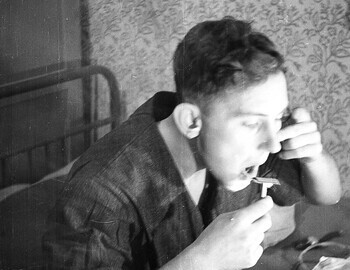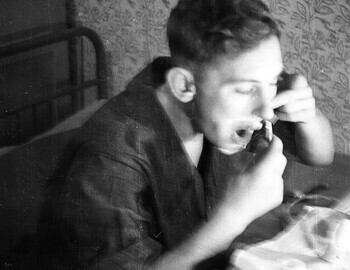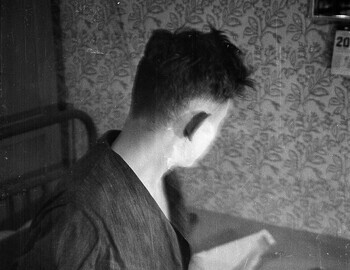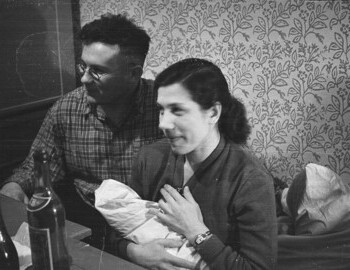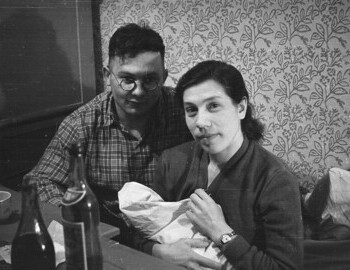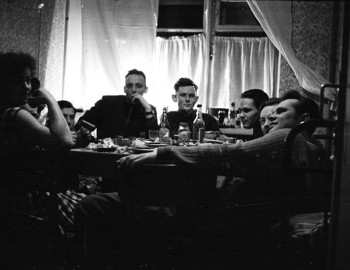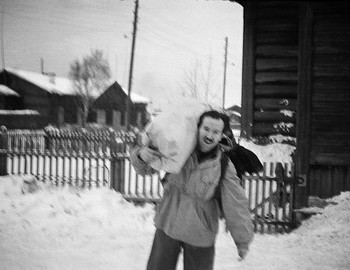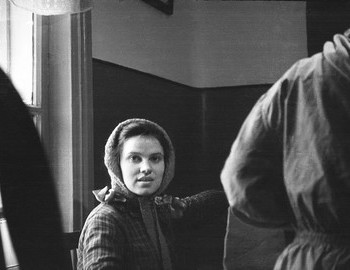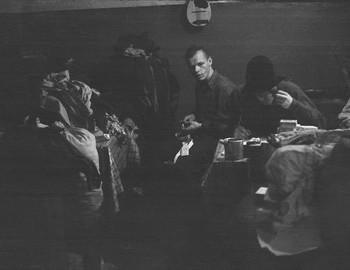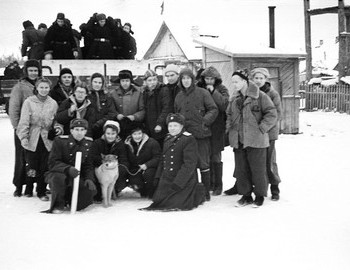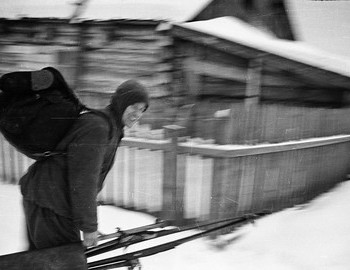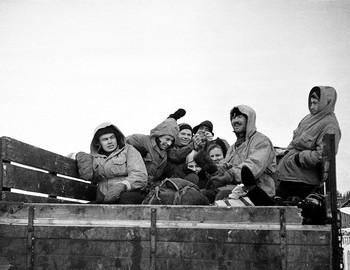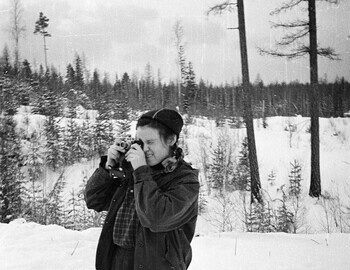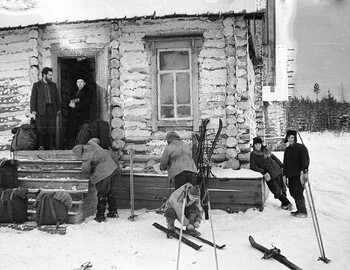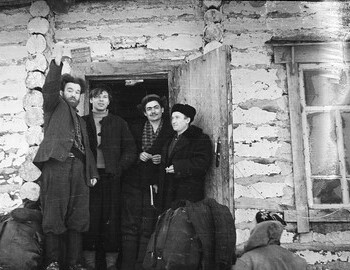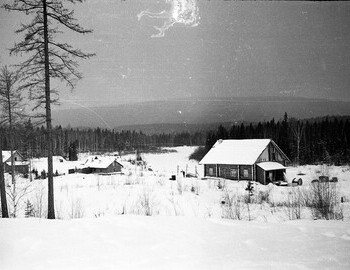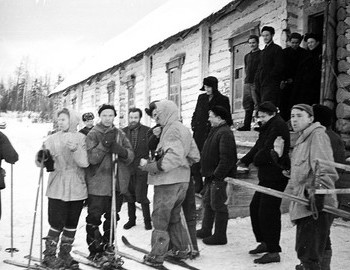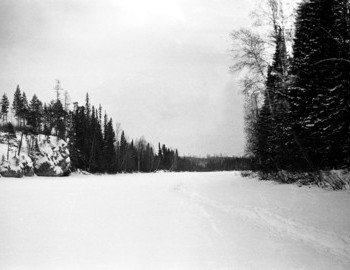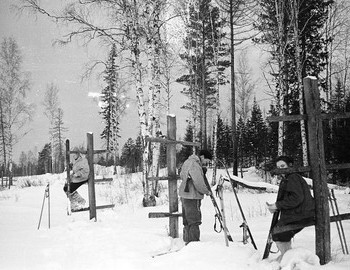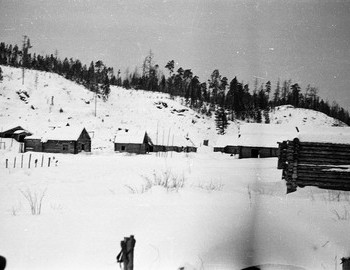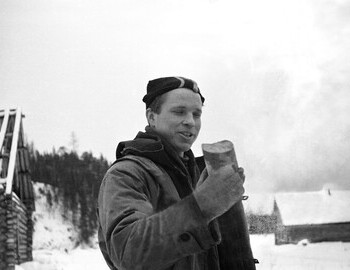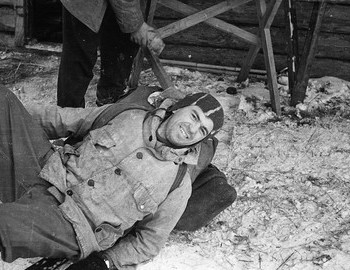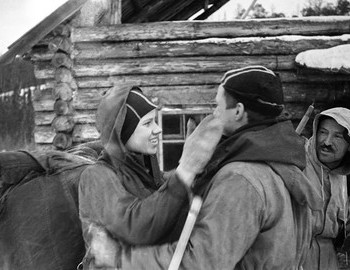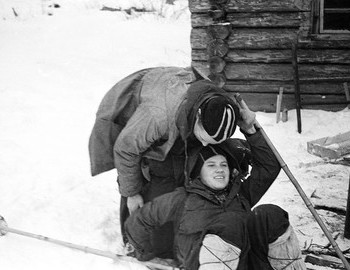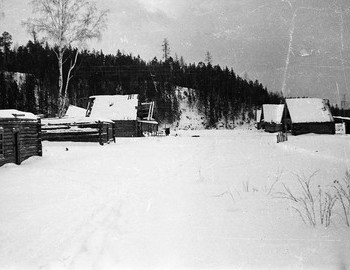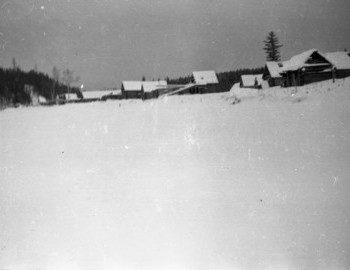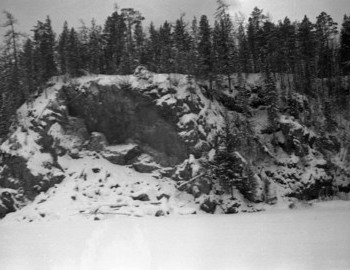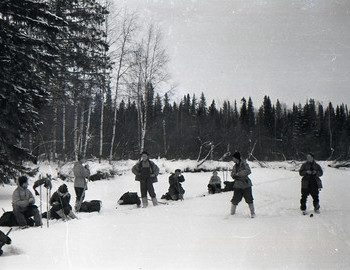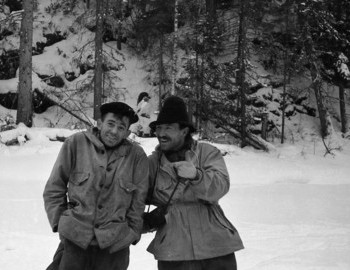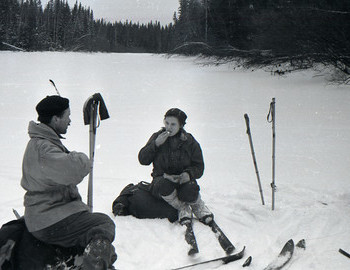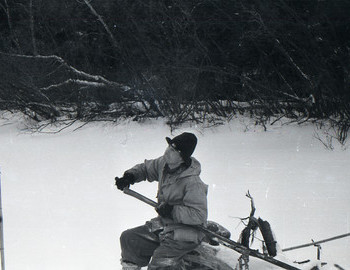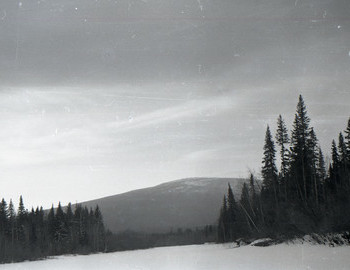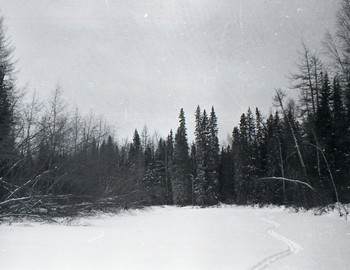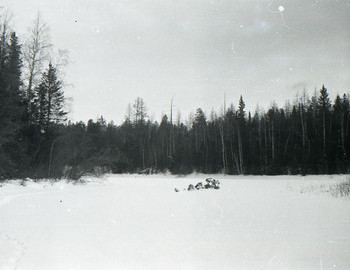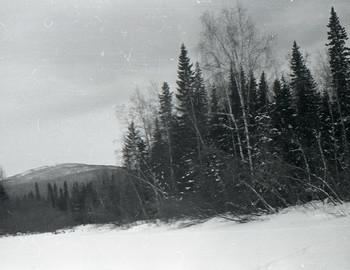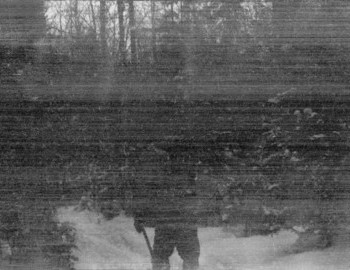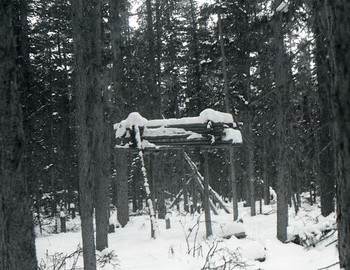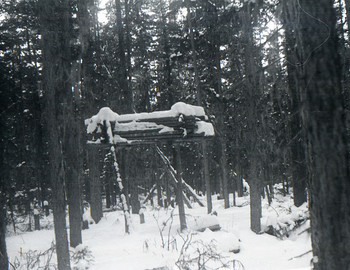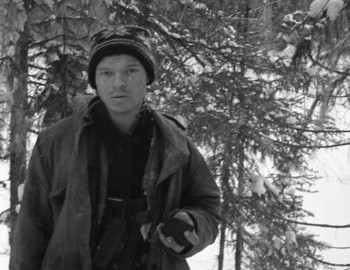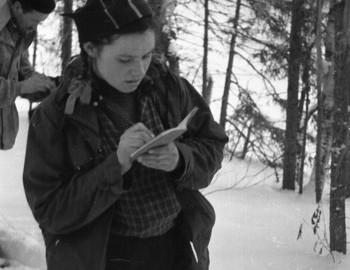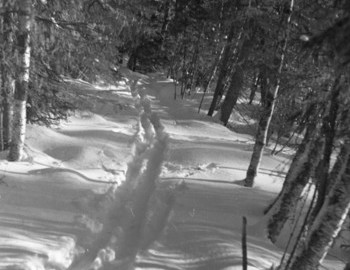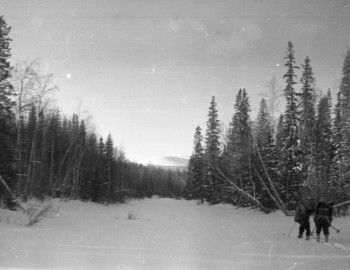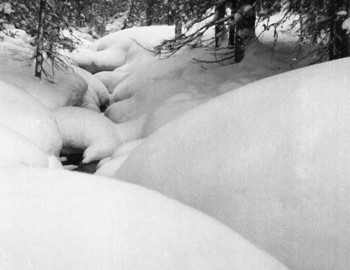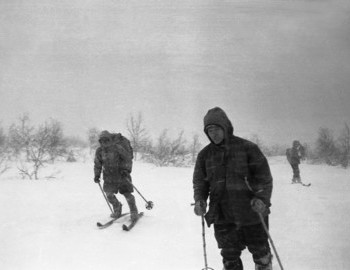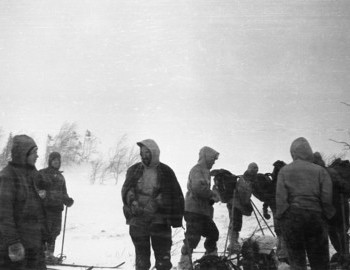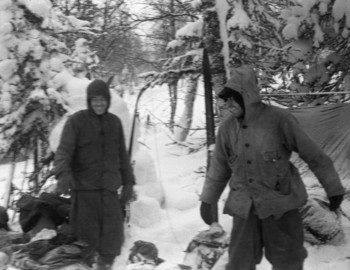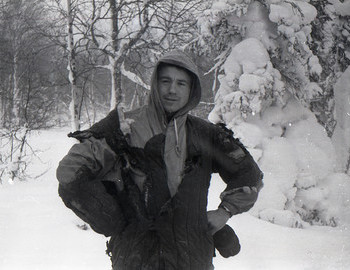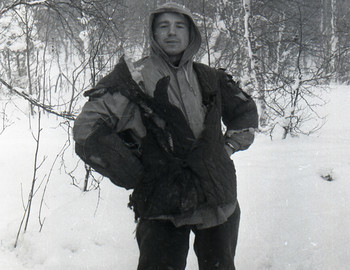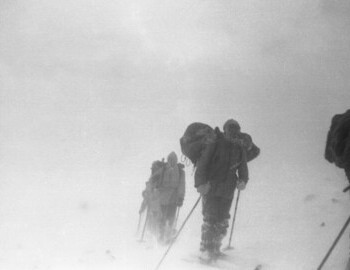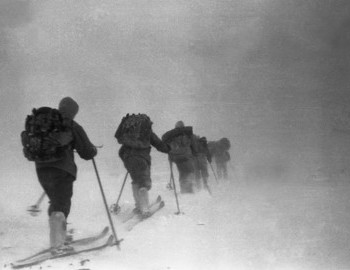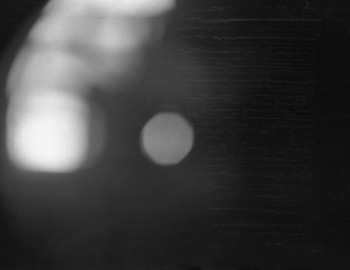
Krivonischenko's camera
The first 9 photos in film Film №6 are not related to the hike. They include household interior. In frame №9 we see Georgiy Krivonischenko sitting at a table among friends. Photo is staged. That Krivonischenko appears on its own film is not contradictory - he just handed the camera to a friend so that he appears in his own film. Dyatlov's Pass pictures start with frame №10. Semyon Zolotaryov is photographed carrying a backpack and a bag of provisions on his shoulder. Zolotaryov knows that he is photographed, he is alone in the frame. This is a "telling" photo - Krivonischenko chose to photograph Zolotaryov first of all members. It could be because they knew each other from before and had a friendly relationship. Frame №11 is a portrait of Zina Kolmogorova - photo reveals a sudden snapshot of a kind soul. Frame №12 is a very interesting "Old Flemish masters" style photo with Igor Dyatlov and Nikolay Thibeaux-Brignolle recognizable by his hat. Above Dyatlov's head hangs Krivonischenko's mandolin. Kneeled behind the table is Rustem Slobodin. The way Krivonischenko cut out of the frame Lyudmila Dubinina could be intentional and telling of his feelings about her. Frames №13-14 the group piled into a truck in the afternoon of January 26, 1959, leaving Vizhay to 41st District. This photo is considered formal, documenting their transportation. To us these photos are interesting as some of the few where Krivonischenko included Lyudmila Dubinina and Yuri Doroshenko. Frame №15 with Kolevatov, who didn't care much to be photographed. He is not on many photos. On frame №15 the group is at 41st District with some soldiers, woman with glasses and so on. What's interesting in this photo is that Dyatlov, the group's leader doesn't look at the camera and instead choosing a central place in the photo he's somehow apart from the rest, as if he didn't care to be in the picture. Another interesting detail is that it doesn't seem to be too cold because the girls are keeping their collars unbuttoned. Koletarov though appears on all the photos with his hoodie on. In frame №19 is Zina Kolmogorova with her own camera, Krivonishenko liked taking pictures of her. Frames №25-26 captured the parting of the hikers with the local workers. The interesting thing about them is that they are both made seconds apart from the same standing point, the photographer just turned slightly on the second one to get Thibeaux-Brignolle in the frame. We think Krivonischenko had very good relationship with Thibeaux-Brignolle. Why did he stayed under the cedar with Doroshenko and not Zolotaryov and Thibeaux-Brignolle who he liked better? In frame №28 Dubinina, Zolotaryov and Kolmogorova (in same order on the photo left to right) are sitting or staying by crosses for drying fish. The photo is not staged, they don't even look in the camera. The mysticism of this photo is uncanny since they all be dead in a few days. Kolmogorova is next to Zolotaryov on quite a few photos, talking or just next to him. It looks like they are friendly to each other. She didn't stay with neither Krivonischenko nor Zolotaryov at the time of the incident. Frames №31-32 the always smiling Thibeaux-Brignolle tripped over a saw horse probably while he was doing his boots. There is an interesting detail - we see behind his shoulder a felt boot which he used as indoors "slippers". This is what he was wearing on the fatal night of February 1 when he was running down the slope. This also means that whatever scared away the hikers started developing after Thibeaux-Brignolle changed into his slippers.
Film №1, frame №3 hikers are resting. Weather is not cold. Members are evenly distributed, there is no division into groups of preference, no sense of tension or threat (in which case people in the photo would have been facing each other, stayed in groups or formed a circle). Very peaceful photo. There is similar photo in film №4. Frame №4 is Krivonischenko's selfportrait. He must have handed somebody his own camera and is posing with another camera. We can see his Finnish knife. He didn't hide it although back in 1959 in the former USSR it was a big deal to have a Finnish knife. It was considered a cold weapon and it required a permission from the police to carry one. Tibo carried a Finnish knife without permission too. Only Kolevatov had his officially, but we display it publicly. On frames №5-6-7 the group is having a very jolly time. There are similar photos on films №4 and 5. There is a duel with cameras between Thibeaux-Brignolle and Krivonischenko where they exchanged cameras so they can be photographed on their own films. Frame №8 Zolotaryov and Kolmogorova chatting, Thibeaux-Brignolle is cut out of the frame, we see his leg only. Next photo frame №9 is made to get a shot of Thibeaux-Brignolle specifically because he was left out of the previous photo. This is an example that Krivonischenko makes an extra effort to include in photos the people he likes. Frame №18 shows Mansi markings that tell how many local hunters passed through this area and the family clan to which they belong. Mansi are people of the north. Very interesting and unique people that inhabit the Northern Polar Ural, closed to the Tyumen region. They have a written language and leave characteristic signs on forest trees. In frame №19 Igor Dyatlov not in the best of moods. In frame №22 Kolevatov knows that he's being photographed, he looks into the camera but he stays indifferent. Slobodin is looking at the Mansi markings, he is open, unencumbered. Zolotaryov is looking down intentionally. He doesn't like his photo taken. Kolevatov's stealth behavior in front of thе camera speaks of a self-contained character, capable of planning and control over his emotions. It doesn't mean he can't be the heart of the pack, or that he is incapable of closeness and concern for others. We are referring to the fact he doesn't seem to rush into things so common for group behavior patterns. On frame №28 the group is almost on the ridge above r. Auspiya. Dyatlov is making the crucial decision if to continue or go back, and if they had continue to r. Lozva the group would have been camped away from Kholat Syakhl. The last entry of Dyatlov's diary says that they decided to go back and spend the night at a camp site on Auspiya river. On the photo Dyatlov is surrounded by Zolotaryov, Kolevatov and Krivonischenko (the photographer). Dyatlov and Zolotaryov are discussing something important. The conversation is unpleasant. We can say that because Zolotaryov is positioned sideways to the person he's talking to (Dyatlov), his head turned and slightly forward, his hands in front of his abdomen, it's a pose when you subconsciously are ready for a surprise attack. Dyatlov seemed surprised and defeated. He is not prepared to hear what Zolotaryov has to say. the distance between the two is 1.5m which is a lot for a friendly exchange. The rest of the group had distanced themselves from the conversation unable to influence the decision. Controversy about why the group pitched their tent at this spot on the night of the incident. Frame №29 shows Kolevatov and Thibeaux-Brignolle in front of the tent talking and smiling, you can tell they have good friendship. Another thing that is notable about this photo is the calm weather in the forrest, so much different from the piercing wind outside the treeline. In frames №30-31 shows Slobodin posing for laughs in "Yurkin's quilted jacket. He (Krivonischenko) cursed a lot." according to Zina's diary. Frames №32-33 are shot above tree level, in the open space, on a completely bare hillside, sweeps of snow, strong wind, poor lighting. Dyatlov's group is on their way to Kholat Syakhl. The fact that the tent on the back of one of the hikers is not folded properly (it's carried in a wide roll), clearly indicates that the trek on 1 February was originally planned to take place entirely in the open (outside the forest). It would be hard to walk between the trees branches with something so wide attached to your back. Frames №34 technological shot made in the photo lab before the film was taken out of the camera. We are mentioning it here only because this photo has been inspiring wild speculations for decades now. Brief summary »
- First of all, it should be noted that the "range of psychological comfort" of the photographer does not include all members of the group. Krivonischenko was fond of Semyon Zolotaryov, Nikolay Thibeaux-Brignolle, Zina Kolmogorova, Igor Dyatlov and Rustem Slobodin (listed in order of decreasing degree of sympathy). This speaks of the integrity of the group. There were favorites.
- Krivonischenko ignored Yuri Doroshenko and Lyuda Dubinina. We are not talking about the antagonism or hostility, more like Georgiy didn't have much in common with them. The reason could be difference in age, interests, psychological incompatibility with the said people. There is nothing wrong or fatal about this. Every normal person has peers that fall into his personal "zone of ignoring" (and he thus gets into such "zone of ignoring" of other people).
- Kolevatov looks withdrawn and detached, he didn't like ot be photographed, much like Zolotoryov, and when he did he usually looks emotionless and indifferent. Nearly always with his hood on, even if the weather is warm and calm. Kolevatov appears as if he doesn't belong to the group and doesn't identify himself with its members.
- Zolotoryov definitely didn't like his picture taken. If he knows that he's being photographed he usually hides his face by looking down. The only exception are the photos on Lozva river where he switches hats with Thibeaux-Brignolle and we make the assumption that the skiers may have treated themselves with a shot or two of alcohol.
- For an average amateur photographer in similar situation when traveling with a group of people the number of inanimate photos is around 20%. In first film №6 that number is 18%. In second film №1 that number increases to 44% which is indicative of the photographers increased internal stress, anxiety, guilt and uncertainty. This can be caused by the deteriorating health of Krivonischenko which we think is not the case. The tension began to show in his photos after they left North-2 settlement i.e. when the group was on their own. Withholding some information that could suggest a possible negative development can explain such feeling of internal stress.
- Frame №34 testifies to the fact that Krivonischenko's camera was left with cocked shutter. It is possible that this is just a habit, although this is rather unusual for an experienced photographer, because it would result in losing a few frames from each film. His camera was the only of the four cameras found in the tent, left with the cocked shutter. Another explanation is that being in poor visibility conditions when the last photos were taken on the slope, Georgiy wanted to be ready for immediate shot fo something he was expecting to happen. We do not know what exactly Zolotaryov, Krivonischenko and Kolevatov were preparing for, it is possible that Krivonischenko with his camera had to be a decoy, enabling Zolotaryov do his business quietly. By the way, most likely, Semyon did it, otherwise he would not have kept his second camera until his death (the film in his camera was totally ruined by moisture). Krivonischenko cocking the shutter is a very important signal that he was preparing for some events on the slopes, unlike the holders of other cameras - Dyatlov and Slobodin. Among other oddities of the last days (ascent and descent from the pass on January 31, and a very short distance covered on February 1) the cocked shutter suggests that some members of the group ware preparing for some anticipated events in the afternoon of February 1 in this area, but the development for reasons unclear to us resulted in a tragic outcome.

